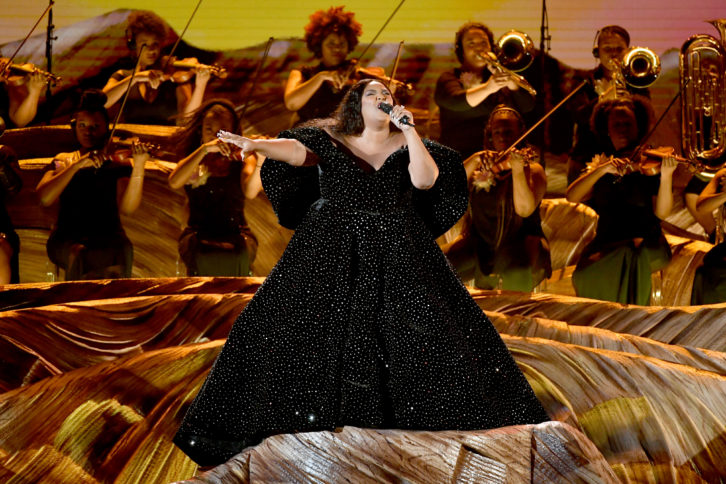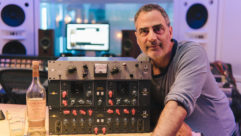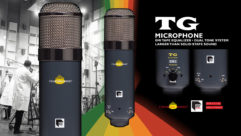
Every year, the award-winning veteran audio production crew behind the annual GRAMMY Awards telecast strives to further raise the bar on the already unparalleled audio quality of “Music’s Biggest Night.” This year, in a first for the show, the audio team implemented a Dante Audio-over-IP network.
This year, the GRAMMY Awards show was broadcast live from the Staples Center in downtown Los Angeles on the CBS network on January 26. Performers included Best New Artist nominees Lizzo; Billie Eilish; and Lil Nas X, as well as Tyler, the Creator; H.E.R.; Gary Clark Jr. with the Roots; and Demi Lovato, among many others.
The new AoIP transport scheme was designed to eliminate the complex and cumbersome signal-splitting system that The Grammys have long been employed to feed signals from the show’s multiple stages to the two front-of-house and two-stage monitor consoles, as well as the two music mixing consoles and the broadcast audio production desk in three remote trucks. In addition to the efficiencies afforded by digitally transporting dozens of microphone signals over fiber and making them available everywhere simultaneously, the new system design delivered a noticeable improvement in audio quality.
“The performance mics sounded a lot clearer to me, because they weren’t going through a splitter,” says Eric Schilling, one of two broadcast music mixers stationed in a pair of M3 (Music Mix Mobile) trucks parked outside the Staples Center. “I didn’t feel like I had to ‘carve out’ as much as I do on a typical mic through a splitter, where it might be a little murky in the low end.” In fact, he says, “I found myself doing less processing on the vocals in terms of both low end and high end.”
“We knew we were going to get a better frequency response without all the spitting going on,” says longtime GRAMMY Awards audio coordinator Michael Abbott. “But it was substantially noticeable. Eric told me he wasn’t having to carve out a lot of the 100 to 300 cycles that he normally would on the RF microphones because of the degradation of the signal going through the splitters and into all the different consoles.”

Schilling reports that he worked on a show with a digital audio transport scheme several years ago and recommended that the GRAMMY Awards show also adopt AoIP networking. Abbott, in collaboration with other engineers on the show and with Audinate, developer of the Dante protocol, designed a system incorporating Focusrite RedNet D64R MADI bridges to transport signals from the Sennheiser Digital 6000 and Shure Axient RF microphones supplied to the show and coordinated by Soundtronics to the mix engineers. The eight RedNet D64R units delivered the primary and redundant Dante streams to the four mix locations via the respective DiGiCo, Lawo and Calrec console MADI interfaces.
Abbott reports that Jeff Peterson, PA designer for ATK Audiotek, which has long provided house sound production equipment and services to the GRAMMY Awards telecast, oversaw the preliminary Dante network buildout ahead of the show. “Due to the tight production schedule – two days; 16 hours – that we have available to set these shows up, ATK did the build-out of the network off-site. This allowed for a minimal setup on-site in deploying the Dante sources to the mix platforms.” Abbott explains.

A number of artists, including telecast show host Alicia Keys, preferred to use their Shure analog wireless microphones when performing, Abbott also reports. “They don’t support the Dante protocol, so we added some Focusrite RedNet MP8R preamps to gain them out for noise floor and introduce them as a source into the network.” Focusrite RedNet D16R AES-to-Dante interface units were also available to accept AES inputs from RF mic systems with no networking connectivity.
Ron Reaves, FOH music mixer and another long-serving member of the GRAMMY Awards audio team, also noticed a significant improvement in the response of the Dante-enabled wireless vocal mics through the P.A. “The mics sounded better right out of the gate, so I had to do a lot less EQing. It was just beautiful. The mics were very quiet with very little handling noise, and there was a lot more top end than we were used to having,” he says. “To the point where there were a couple of performances on the satellite stage near our position where I had to apply a low-pass filter and take a little top-end off, because they were in front of the P.A.”
Production budgets permitting, says Abbott, the plan for next year’s show is to also incorporate the approximately 400 back-of-house channels, including audio tracks and video playback, into the AoIP network. The following year, he says, “The third phase would be to add all the musical instruments.”
Sennheiser Digital 6000 Wireless Microphone System

In another first for the Grammys, Sennheiser’s Digital 6000 wireless microphone system helped deliver a completely digital signal path for wireless vocal mics. With performances by Lizzo, Brandi Carlile, Blake Shelton and others, more than 20 channels of Sennheiser Digital 6000 RF were deployed in both production and MC capacities at the Staples Center in Los Angeles.
Lizzo quickly set the tone for the show, opening the GRAMMY Awards by offering a heartfelt remembrance of Kobe Bryant and delivering a riveting medley of “Cuz I Love You” and “Truth Hurts”. Singing through a Sennheiser SKM 6000 handheld transmitter coupled with an MD 9235 capsule, the 8-time GRAMMY nominee – who also won the evening’s first GRAMMY Award with “Best Pop Solo Performance” – showcased her amazing talent, versatility and charisma, supported by an orchestral ensemble and several ballerinas. Towards the end of the performance, Lizzo’s flute – adorned with a Sennheiser SK 6212 wireless mini-bodypack transmitter and an ME 104 lavalier microphone – was lowered by a trapeze as she careened into a breath-taking instrumental solo.
“The SKM 6000 and MD 9235 has been my go-to combination since the D6000 line debuted – the capsule is a perfect fit for Lizzo’s powerful vocal,” says Brandon Blackwell, FOH for Lizzo. “She is a very strong vocalist and the frequency response does not seem to collapse, losing the warmth in the low mid frequencies and the high-end definition.” For her flute performances, Blackwell says that going wireless has been liberating: “When I first joined, Lizzo was playing her flute into her vocal microphone on a stand. Now, with the SK 6212 transmitter, she can play when and wherever she wants. The transmitter is so small and lightweight, that you can barely see it. Paired with the cardioid ME 104 lavalier microphone and some precise placement by our Monitor Engineer/Flute Tech Loreen Bohannon, we get a rich sound from her flute.”
In light of an ever-congested RF environment and an unrelenting demand for wireless frequencies, this year’s technical deployment was truly a milestone accomplishment. After receiving the microphone signal, each receiver channel of the Sennheiser Digital 6000 wireless was then relayed across a dual-redundant Dante network, which carried multiple streams of identical multichannel audio all the way to various digital mixing consoles located throughout the venue.
“This is the first time the Grammy Awards has been able to deliver the vocal wireless mics on a completely digital path all the way to every mixing console,” observed Jeff Peterson, PA Designer of ATK Audiotek. According to GRAMMY Awards audio coordinator Michael Abbott, by combining a high-quality digital wireless microphone system and a Dante network as a transport protocol, the show has achieved a vastly improved frequency response.
Michael Abbott, who has been using Sennheiser systems on the GRAMMY Awards for more than 30 years, specified the Digital 6000 system for all the production and emcee microphones at this year’s show. “We appreciate the frequency agility of the Digital 6000 in such an RF-intense environment,” he says. “This allows us to deploy multiple transmitters and receivers with reliable performance.” “The RF on this show is complex to say the least,” adds Peterson. “Monitoring, control, and flexibility are the features that help us the most, and we benefit considerably by the Digital 6000’s resistance to interference, in addition to its efficient use of bandwidth.”
Stephen Vaughn, Coordinator for Soundtronics Wireless, ensures that all the wireless microphones and in-ear monitors work in harmony with each other for the duration of the program. “The Digital 6000 is impressive,” he states. “The amount of frequencies I can get in one TV channel is the part that really helps me out in today’s environment. Even if you don’t have a scope, you can just look at the quality meter on the front of the unit and tell whether or not you are taking on interference or not. Also, the fact that the Digital 6000 transmitters use rechargeable batteries is a key factor for me, since I am tired of dumping hundreds of batteries in the trash. With the 6000, you just recharge them and just reuse them. I am leaving a much greener footprint during these shows and I feel more comfortable using these over disposable batteries.”










